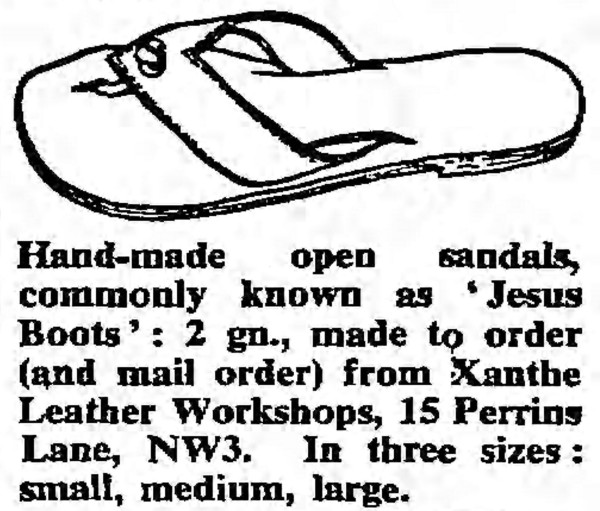The phrase Jesus boots has had at least two meanings in American English.
1-: Used of Doukhobors (i.e., members of a Christian sect that originated in Russia, many members of which emigrated to Canada in the late 19th and early 20th centuries), the phrase Jesus boots has denoted bare feet.
This use of Jesus boots occurs in the following two texts:
1.1-: In Crazy Dukhobors Freeze and Famish at Yorkton’s Gates, published in The Minneapolis Journal (Minneapolis, Minnesota, USA) of Wednesday 29th October 1902:
Special to The Journal.
Winnipeg, Man., Oct. 29.—A special dispatch says 1,600 Dukhobors have marched on Yorkton, and the town has capitulated without firing a shot. […]
Simeon Tcherninkov, who talks little English, and whose bare, brown feet bore witness to his insane zeal, explained that they were looking for a new light—“looking for Jesus.” When asked where were his boots, he held up his naked foot and cried, “Jesus boots,” while the flickering light of lost reason gleamed fitfully from his eyes.
1.2-: In “As Christ Would Live.”, published in the New-York Tribune (New York City, New York) of Sunday 10th January 1909:
It is obvious that even if it were possible, as it is not, it would be undesirable to live literally as Christ is recorded to have lived. The misguided Doukhobors tried that, and, recalling that He did not wear such footgear as people do here and now, they tramped through snow and ice barefooted, fanatically boasting of their bleeding and frozen feet as being clad in “Jesus boots.”
2-: Used of young persons, the phrase Jesus boots has denoted open-toed leather sandals of a simple or functional style.
This use of Jesus boots refers to the type of footwear traditionally associated with Jesus, from depictions in illustrations and paintings. It occurs in the following two texts:
2.1-: In the following from The Oregonian (Portland, Oregon) of Wednesday 26th May 1965:
Students Plan Sitdown
Jefferson High Fights ‘Battle Of The Beatle’The battle of student hairdos, dress and the wearing of what the kids call “Jesus boots” is raging at Jefferson High School.
[…]
Students complained Tuesday that they now have been ordered to quit wearing “Jesus boots,” sandals, all black clothing, and that girls’ bangs have been ordered cut if the bangs are not at least an inch above the eyebrows.
2.2-: In the column Generally Speaking, by Frances R. Williams, published in The Marysville Advocate (Marysville, Kansas) of Thursday 29th July 1965:
From Kansas comes the comment on what boys wear on a college date—“Sloppy old cut-offs both jeans and sweat shirt. It there are holes or rips the better, also sandals! If they want to be really dressed up, they wear plaid Bermuda shorts and white shirt but keep the sandals by all means. Toes are back in style again.”
While there is a college boy around under foot, a lot of the time—at this home, he seems to conform with the regulation togs, but around the university campus, one sees everything, including long shoulder-length hair and beards. And of course Beatle style hair cuts among the male sex.
Sandals are called “Jesus boots” by some youngsters, according to a Berkeley Junior high teacher.
The U.S. evangelist Billy Graham (1918-2018) was quoted as associating Jesus boots with hippies in Billy Graham Says Student Unrest Is Search for God, published in the Corpus Christi Caller (Corpus Christi, Texas) of Monday 29th July 1968:
“Jesus had long hair. So have our hippies. And at least in the United States they wear Jesus boots (sandals) and this seems to express their hidden longing for God.”
The variant Jesus sandals occurs, for example, in The Sound of Mountain Water. The Changing American West (Garden City: Doubleday & Company, 1969), by the U.S. author Wallace Stegner (1909-1993)—as quoted in The Evening Star (Washington, D.C.) of Monday 12th May 1969:
Sometimes he wonders if the characteristic American novelist of the 1960s won’t turn out to be a Negro of the Jewish faith, born in Alabama and reared in Harlem and expatriated to Paris, where he picks up a living as a hustler in a homosexual joint, wearing beard and Jesus sandals and taking it in the vein and making a devout effort to look, sound, act and write like something by Norman Mailer out of Djuna Barnes.
The phrase Jesus boots has come to be used in British English—as in the following, on women’s fashion, from The Observer (London, England) of Sunday 2nd July 1967:
BARDOT PUMPS, fashionable for 10 years, are still the best flat shoes, £1 19s. 6d. at Galeries Lafayette, Regent Street, London W1. (English ones are no good, they are just ballet shoes and go too high round the toes.) If you want a change, try these:—
Hand-made open sandals, commonly known as ‘Jesus Boots’: 2 gn., made to order (and mail order) from Xanthe Leather Workshops, 15 Perrins Lane, NW3. In three sizes: small, medium, large.
A Pair of Jesus-Boots (London: Jonathan Cape, 1969), by the British author Sylvia Sherry (née Blunt – born 1932), is a novel for children and young adults, set in Liverpool, in north-western England.

